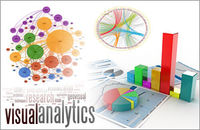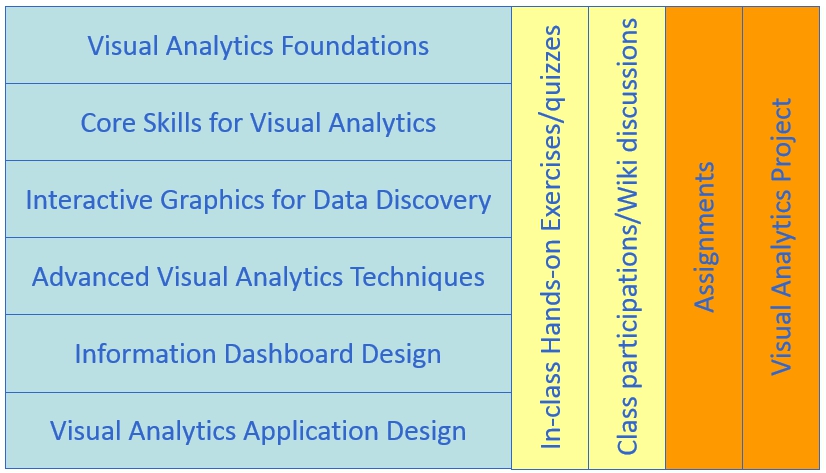Difference between revisions of "Course information"
| Line 19: | Line 19: | ||
| style="font-family:Century Gothic; font-size:100%; solid #1B338F; background:#2B3856; text-align:center;" width="20%" | | | style="font-family:Century Gothic; font-size:100%; solid #1B338F; background:#2B3856; text-align:center;" width="20%" | | ||
; | ; | ||
| − | [[ | + | [[VAProject| <font color="#FFFFFF">Visual Analytics Project</font>]] |
| style="font-family:Century Gothic; font-size:100%; solid #1B338F; background:#2B3856; text-align:center;" width="20%" | | | style="font-family:Century Gothic; font-size:100%; solid #1B338F; background:#2B3856; text-align:center;" width="20%" | | ||
Revision as of 21:47, 4 August 2016
|
|
|
|
|
|
Contents
Synopsis
Data analysis and communications can be fun! With visual analytics techniques and tools, everyday data analysts from various disciplines such business, economic, sociology, political science and public policy can now synthesize information and derive insight from massive, dynamic, ambiguous, and often conflicting data without having to deal with complex statistical formulas and programming. Many companies and organization took notice when Gartner cited visual analytics as one of the top five trends transforming business intelligence.
In this course, students learn how to use data visualization and interactive analytic tools and techniques to interact with data of different formats from various sources, explore the expected relationships and discover unexpected correlations and patterns. You will also acquire the skills for building cutting edge visual analytics application based on principles and best practices from graphic design, visual arts, perceptual psychology, cognitive science and interfaces design.
For more detail information and learning outcome please refer to the course design document. [1]
Learning Objectives
Upon successful completion of the course, students will be able to:
- Understand the basic concepts, theories and methodologies of Visual Analytics.
- Analyse data using appropriate visual thinking and visual analytics techniques
- Present data using appropriate visual communication and graphical methods.
- Design and implement cutting-edge Visual Analytics system for supporting decision making
Basic Modules
This course comprises ten integrated components as shown below:
Course Assessment
The assessment of this course consists of four major components, namely: class participation, individual assignment, visual analytics project. There will be no mid-term test or final examination for this course.
Class Participation
A strict requirement for each class meeting is to complete the assigned readings and to try out the hands-on exercises before coming to class. Readings will be provided from the textbook on technical information and from provided documents and articles on business applications of Visual Analytics. Students are required to review the recommended readings and class exercises before coming to class. Without preparation, the learning and discussions would not be as meaningful. Student sharing of insights from readings and hands-on exercises of assigned materials in class participation will form a large part of the learning in this course.
In this course class participation includes participation in the discussion on course wiki. All students are required to post at least one substantive discussion comment or question pertaining to each lesson, set of readings, and hands-on exercise. Comments or questions for each lesson must be posted within one week after the lesson.
Examples of good comments include and not confine to the followings:
- Clarification of some points or details presented in the class
- Links to web resources or examples that pertain to a lesson or reading with reasons
- Question about the readings or answers to other peoples questions
- Reflection on skills learned through working on an hands-on exercise.
Individual Assignments
There are three assignments that are due throughout the term. Students may work together to help one another with computer or Visual Analytics issues and discuss the materials that constitute the assignment. However, each student is required to prepare and submit the assignment (including any computer work) on their own. Cheating is strictly forbidden. Cheating includes but not limited to: plagiarism and submission of work that is not the student’s own.
All assignments due are to be uploaded into the Assignment Dropbox strictly before the official due dates. Late work, will be severely penalised. Students must check and confirm on Wiki the assignment due dates.
The assignments will be graded on a scale from 0 to 10. Scores of 7 and 8 are given when the assignment is essentially done completely and correctly. Scores 9 and 10 are reserved for complete and correct homework where extra initiative or innovation clearly sets the completed work above the simple, perfunctory and satisfactory completion of the assignment.
Visual Analytics Project
The purpose of the project is to provide students first hand experience on collecting, processing and analysing large business data using real world data. A project may involve developing new methods or implementing visual analytics system to support analytic tasks in specific domains. Alternatively, a project may be in the form of application development by integrating analytical tools within a visual analytics environment. Students are encouraged to focus on research topics that are relevant to their field of study. It should address a concrete visual analytics problem and should propose a novel and creative solution.
For more details please refer to Visual Analytics Project page
Grading Summary
The grading distribution of this course is as follows:
- Class Participation 20%
- In-class discussion/quiz 10%
- Lesson Comment and Visual Analytics Critics 10%
- Individual Assignments 35%
- Assignment 1 10%
- Assignment 2 10%
- Assignment 3 15%
- Visual Analytics Project 45%
- Project wiki 5%
- Project poster 5%
- Townhall presentation 10%
- VA research paper 10%
- VA application 15%

